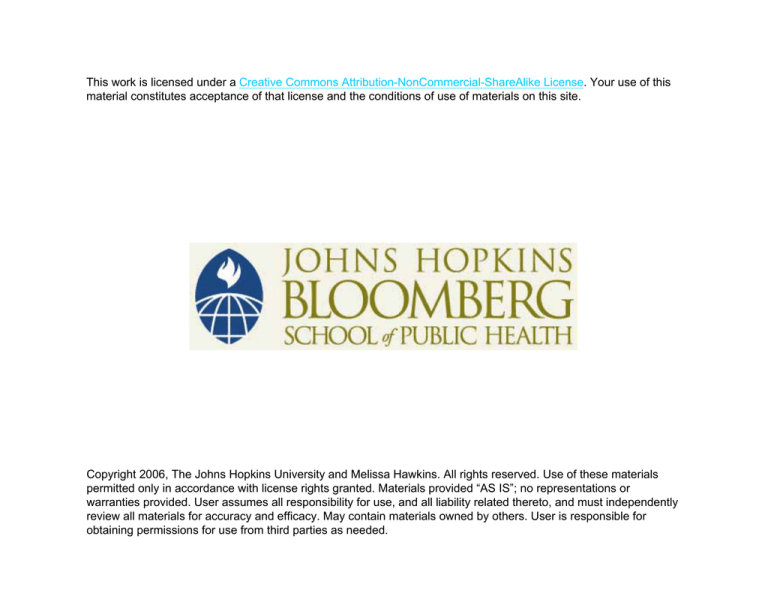
This work is licensed under a Creative Commons Attribution-NonCommercial-ShareAlike License. Your use of this
material constitutes acceptance of that license and the conditions of use of materials on this site.
Copyright 2006, The Johns Hopkins University and Melissa Hawkins. All rights reserved. Use of these materials
permitted only in accordance with license rights granted. Materials provided “AS IS”; no representations or
warranties provided. User assumes all responsibility for use, and all liability related thereto, and must independently
review all materials for accuracy and efficacy. May contain materials owned by others. User is responsible for
obtaining permissions for use from third parties as needed.
Evaluating the Prevention of
Infant Mortality
Melissa Hawkins, PhD
Bloomberg School of Public Health
Section A
Reducing the Proportion of High Risk
Pregnancies
Reducing the Proportion of High
Risk Pregnancies
Reducing the number of unwanted
pregnancies
Increasing spacing between pregnancies
Reducing the number of teenage
pregnancies
4
Title X of the Public Health
Service Act (1970)
Provides funds to non-profit groups to
provide family planning services (regardless
of income or age)
Provides support for educational programs
and research in contraceptive development
5
Medicaid (1965) Title XIX
Health insurance program designed to
meet the needs of those unable to afford
care, especially women and children
Financed jointly by the federal government
and the states
Continued
6
Medicaid (1965) Title XIX
Medicaid program was intended to improve
access to mainstream medical care for
those eligible
Medicaid has never provided universal
coverage for the low-income population
Majority of public money spent on family
planning from Medicaid
7
Impact of Title X and Medicaid
on Birth Outcomes
Fertility
– Is the hypothesized reduction a result of
a reduction in the pregnancy rate or an
increase in the pregnancy termination
rate?
Neonatal and infant mortality
– Several studies found family planning
services related to reductions
8
Fetal and Infant Mortality
Reviews Programs (FIMR)
The U.S. has a long history of populationbased strategies to improve MHC
Perinatal health systems initiatives in local
communities
FIMR—community-based process aimed at the
improving the system of perinatal health care
– Development of recommendations is key
component
Recent nationwide evaluation of FIMR
programs
9
Section B
Programs that Address Broad
Societal Factors and Facilitate Entry
into Prenatal Care
Programs that Reduce Financial
Barriers to Access
Healthy Start
– Massachusetts Department of Health—
evaluation, 1988
Medicaid Expansions
11
Programs that Reduce Financial
Barriers to Access
There are three primary sources of funding
for prenatal care services for low income
women
– Medicaid
– Title V Maternal and Child Health Block
Grant Program
– Local Health Departments
Continued
12
Programs that Reduce Financial
Barriers to Access
Expansions for pregnant women and their
newborns were accomplished in four areas
1. Severing the link between Medicaid and
Aid to Families with Dependent Children
2. Simplifying and shortening the eligibility
process
3. Enhancing services provided by the
program
Continued
13
Programs that Reduce Financial
Barriers to Access
Expansions for pregnant women and their
newborns were accomplished in four areas
4. Increasing provider participation in the
program (since 1989)
Some enhancements have been at the
option of the states, but many have been
required
Continued
14
Programs that Reduce Financial
Barriers to Access
Removal of financial barriers alone will not
eliminate inequities in availability of health
care for low income women
Few studies have evaluated the impact
15
Programs that Improve Capacity of the Health
Care System to Provide PNC or Modify
Institutional Practices of Providers
Pennsylvania Health Beginnings Plus
Program
– To make a comprehensive array of
maternity services available and
accessible to low-income women
Continued
16
Programs that Improve Capacity of the Health
Care System to Provide PNC or Modify
Institutional Practices of Providers
Maternal and Infant Care (MIC)
– Multidisciplinary approach to reduce
barriers to accessing prenatal care
Comprehensive Prenatal Care Clinics
– Comprehensive, coordinated prenatal care
including the following: high risk
screening, education about PTL
prevention, referrals to WIC, counseling,
and general health education
Continued
17
Programs that Improve Capacity of the Health
Care System to Provide PNC or Modify
Institutional Practices of Providers
Improved Pregnancy Outcome (IPO)
– To improve maternal care and
pregnancy outcomes in areas with
excessively high infant mortality
OB Access Project
– Comprehensive program including:
psychosocial assessment, a nutrition
assessment, perinatal education, and a
well-baby exam
18
Programs that Provide Social Supports Without
Specialized, Direct Medical Interventions
Resource Mothers
– To decrease mortality and morbidity
among infants of adolescent mothers
– To promote teenage mothers' health
and parenting skills
Continued
19
Programs that Provide Social Supports Without
Specialized, Direct Medical Interventions
Home Visiting
– To improve child health and
development
Social Support
TAPP
– School based clinic for teens
20
Section C
Programs that Identify Specific Risk
Factors for PTL and Implement
Preventive Measures
Programs that Identify Patients at Risk for PTL
and Institute Early Measures to Prolong Gestation
Pre-term birth prevention programs
– Multi-center randomized controlled trial
Ambulatory home monitoring of uterine
contractions
Continued
22
Programs that Identify Patients at Risk for PTL
and Institute Early Measures to Prolong Gestation
Pre-term Birth Prevention Programs
The effectiveness of these programs has
not been definitively established
Programs usually involve
– Education of provider with regard to risk
assessment and community support
resources
Continued
23
Programs that Identify Patients at Risk for PTL
and Institute Early Measures to Prolong Gestation
Pre-term Birth Prevention Programs
Programs usually involve
– Education of patient with regard to early
signs of pre-term labor and unhealthy
behaviors
– Attempts to treat pre-term labor (e.g.,
tocolysis, bed rest, cervical cerclage,
home visits)
24
Summary of Murphy (1993)
Do methodologic differences explain the
mixed results?
Are etiologic differences in pre-term
delivery obscuring the benefits of these
programs?
Are population differences obscuring the
benefits of these programs?
Continued
25
Summary of Murphy (1993)
Are we looking for improved outcomes in
the right subgroups?
Are inadequate risk screening methods
obscuring potential benefits?
Are our interventions effective?
26
Ambulatory Home Monitoring of
Uterine Contractions
To prevent pre-term birth by early
detection of pre-term labor for women at
high risk of pre-term delivery
Use of external toco-dynamometer to
monitor uterine activity with transmission
of data by telephone to provider
Continued
27
Ambulatory Home Monitoring of
Uterine Contractions
Summary of study results
– Early studies concluded intervention
may be useful but were unable to
determine if it was the monitor or the
daily nursing contacts responsible
– Several randomized controlled trials
showed no benefit
Continued
28
Ambulatory Home Monitoring of
Uterine Contractions
Summary of study results
– ACOG recommends that it is not to be
routinely used until proven to be
effective
29
Programs Focusing on the Elimination
of a Single Risk Factor for LBW/PTB
Cervical cerclage
Antibiotics
Nutrition
Smoking cessation
Substance abuse
Domestic violence during pregnancy
Continued
30
Programs Focusing on the Elimination
of a Single Risk Factor for LBW/PTB
Cervical Cerclage
Used to prevent pre-term birth by
"treating" cervical incompetence (suturing
cervix)
Study results
– Any benefit of cerclage would appear to
be small and there is little evidence that
cerclage is at all effective at preventing
pre-term birth
Continued
31
Programs Focusing on the Elimination
of a Single Risk Factor for LBW/PTB
Antibiotic Therapy
Used to prevent pre-term birth by treating
bacterial infections of the reproductive tract
Study results
– Some recommend that testing and
treating such infections should be a
routine part of pregnancy care, others
more cautious
Continued
32
Programs Focusing on the Elimination
of a Single Risk Factor for LBW/PTB
Antibiotic Therapy
Study results
– Infection may simply co-occur with preterm birth and might not be the cause
Continued
33
Programs Focusing on the Elimination
of a Single Risk Factor for LBW/PTB
Nutrition
WIC (supplemental food program for
women, infants, and children)
– Nutritionally "at-risk" and income <185
percent of the federal poverty level
– Nutritional counseling and vouchers for
specific nutritious foods
Continued
34
Programs Focusing on the Elimination
of a Single Risk Factor for LBW/PTB
Nutrition
WIC (supplemental food program for
women, infants, and children)
– Also encourages prenatal care
– Overall, WIC appears to have a small
effect on the rate of pre-term delivery
Continued
35
Programs Focusing on the Elimination
of a Single Risk Factor for LBW/PTB
Smoking Cessation
Outcomes
– LBW
– IMR
– Quit rates
Most likely, impact is small
Continued
36
Programs Focusing on the Elimination
of a Single Risk Factor for LBW/PTB
Substance Abuse
Care for addicted, pregnant women is
scarce and fragmented
Difficulties in finding adequate care for
pregnant, addicted women include:
– Refusal of care: Many existing drug
programs refuse care to pregnant
women, especially if they are on
Medicaid and are addicted to crack
Continued
37
Programs Focusing on the Elimination
of a Single Risk Factor for LBW/PTB
Substance Abuse
Difficulties in finding adequate care for
pregnant, addicted women include:
– If admission into a program is allowed,
prenatal care, medical care, and child
care are usually not available through
the same program
Continued
38
Programs Focusing on the Elimination
of a Single Risk Factor for LBW/PTB
Substance Abuse
Difficulties in finding adequate care for
pregnant, addicted women include:
– Fractionated outpatient care, which
requires transportation to multiple sites,
is an added burden that reduces
participation and compliance of
pregnant women
Continued
39
Programs Focusing on the Elimination
of a Single Risk Factor for LBW/PTB
Substance Abuse
Programs which provide comprehensive
medical and social care have shown some
positive results
Substance abuse during pregnancy may be
associated with increased risk of pre-term
delivery and other poor pregnancy
outcomes
Continued
40
Programs Focusing on the Elimination
of a Single Risk Factor for LBW/PTB
Domestic Violence During Pregnancy
Reported rates ranging from 4–19%
However, few controlled studies have been
done to establish that abuse leads to poor
outcomes
– Victims of domestic violence tend to
enter prenatal care later in pregnancy
41
Specific Interventions to Treat the
Cause of PTL and Stop Progression
Bed rest
Tocolytics
Continued
42
Specific Interventions to Treat the
Cause of PTL and Stop Progression
Bed Rest
Purpose—To prevent premature delivery
Mechanism of action not understood
Summary of study results
– Randomized studies of bed rest for
multiple gestation pregnancies show
little benefit
Continued
43
Specific Interventions to Treat the
Cause of PTL and Stop Progression
Bed Rest
Summary of study results
– No studies have been reported that
evaluate the potential benefit of bed
rest for singleton pregnancy
– While it would appear to be a low cost
intervention to the medical provider,
income lost to the family can be
significant
Continued
44
Specific Interventions to Treat the
Cause of PTL and Stop Progression
Bed Rest
Summary of study results
– Complications of bed rest include
thromboembolic disease, muscle
atrophy, bone demineralization, calcium
depletion, decreasing plasma volumes,
and decreasing cardiac output
Continued
45
Specific Interventions to Treat the
Cause of PTL and Stop Progression
Tocolytics
Purpose—To stop pre-term labor and
prolong pregnancy in women experiencing
premature labor
– Pharmacologic agent used to inhibit
uterine contractions in pre-term labor
Continued
46
Specific Interventions to Treat the
Cause of PTL and Stop Progression
Tocolytics
Study results
– Prolongation may allow for transport to
a facility more capable of managing a
pre-term infant (e.g., with an NICU)
– Administration of maternal
corticosteroids that may enhance fetal
lung maturity
Continued
47
Specific Interventions to Treat the
Cause of PTL and Stop Progression
Tocolytics
Study results
– Further study is needed to determine
optimal benefit-risk ratio for tocolysis
48
Section D
Improving Birth Weight Specific
Survival by Strengthening Obstetric
and Neonatal Health Systems
Improving Birth Weight Specific
Survival by Strengthening Obstetric
and Neonatal Health Systems
Technological advances
– Neonatal Intensive Care Units (NICU)
– Surfactant
– Steroids
Access to risk appropriate care
(regionalization)
– Maternal and neonatal referral and
transport
50
Technologic Advances: NICU
Ventilation methods were developed and
neonatal intensive care units were introduced in
the late 1960s
– 1976: >125 NICUs; 2004: >900 NICUs
Increased access to NICU associated with
declines in neonatal mortality
However, growth has outpaced the need
Recent study shows between 1980-1995, the
number of hospitals grew by 99%, NICU beds
by 138%, and neo-natologists by 268%
Growth in needed bed days was only 84%
Continued
51
Technologic Advances: NICU
Infants born in hospitals with advanced
neonatal care services available have
higher birth weight specific survival than
infants born in hospitals without such
services
52
Technological Advances:
Surfactant
Manufactured substance which reduces
serious lung disease in premature infants
Recent drop in NMR coincided with
introduction of surfactant
53
Technological Advances:
Steroids
Use of maternal steroids prior to delivery,
even for just one to two days, can increase
lung maturation in premature infants
With widespread use of this therapy,
neonatal mortality may continue to decline
54
Ethical Issues
Current limit of viability is 23–24 weeks
gestation and 500 grams
Infants born >25 weeks gestation have an
excellent chance of a good outcome
Dilemma: Is aggressive intervention
warranted given there is a very small
chance that the infant will survive and not
develop severe, multiple handicaps?
Continued
55
Ethical Issues
Relevant ethical principles include
– Preservation of life
– Alleviation of suffering
– Nonmaleficence
– Patient autonomy
– Justice
56
Access to Risk Appropriate Care
Regionalization refers to a populationbased systems approach involving regional
organization and coordination of perinatal
services
Rationales for regionalization
– Technological advances in perinatal care
are associated with improved survival of
the newborn
Continued
57
Access to Risk Appropriate Care
Rationales for regionalization
– Not cost efficient to provide this care in
all institutions
– Majority of births are uncomplicated
Substantial evidence for the effectiveness
of regionalization
58
Section E
Reducing Postneonatal Mortality
from Specific Causes
Reducing Post-Neonatal
Mortality from Specific Causes
Changing sleep position to prevent Sudden
Infant Death Syndrome (SIDS)
Mandating use of infant care seats to
prevent deaths due to injury
Screening for congenital malformations
60
Changing Sleep Position to
Prevent SIDS
SIDS describes the death of an infant
under one year of age, which remains
unexplained after the performance of a
complete post-mortem investigation,
including an autopsy, the examination of
the death scene and the review of the case
history
Continued
61
Changing Sleep Position to
Prevent SIDS
Leading cause of IM in post-neonatal
period in the U.S.
90% of deaths occur within first six months
Peak in mortality in 2–4 months range
Breast fed babies less likely to die of SIDS
More common in colder months
Prone (face down) sleeping position as risk
factor
Continued
62
Changing Sleep Position to
Prevent SIDS
Meta Analyses of SIDS retrospective casecontrol studies
– Combined RR associated with the prone
sleeping position was 2.4 (CI 1.74, 3.3)
– Evidence strongly suggests a causal
association between the prone sleeping
position of the infant and SIDS
– AAP recommends that infants should be
positioned on their back to sleep
63
Mandating Use of Infant Car Seats
to Prevent Deaths Due to Injury
Increase in infant car seat use has saved lives
and prevented injuries
– 2000, 87% of infants, compared to 60% in
1983
– Of the children ages 0 to 14 years who were
killed in motor vehicle crashes in 2003, more
than 50% were unrestrained
– Fatalities among infant passengers related to
an increased “on-the-road” exposure
Continued
64
Mandating Use of Infant Car Seats
to Prevent Deaths Due to Injury
By 1985, all 50 states had mandatory car
seat laws
Car seat laws vary considerably from state
to state
65
Screening for Congenital
Malformations
Carrier testing
Amniocentesis
Chronic Villus Sampling (CVS)
Maternal Serum Alpha-Fetoprotein
Screening (MSAFP)
Percutaneous Umbilical Blood Sampling
Ultrasonography
Continued
66
Screening for Congenital
Malformations
Evaluating the effect of screening on
postneonatal mortality has two
components:
– Reliability and validity of the screening
test
– Impact of early diagnosis on morbidity
and mortality
67
Reducing Postneonatal
Mortality from Specific Causes
Primary Prevention
– Determine couples who have a significant
risk for a fetus affected with a serious
congenital disorder and counsel them to
avoid pregnancy
Secondary Prevention
– Identify fetuses with serious congenital
malformations and provide opportunity for
induced abortion of affected fetus
Treatment
68








